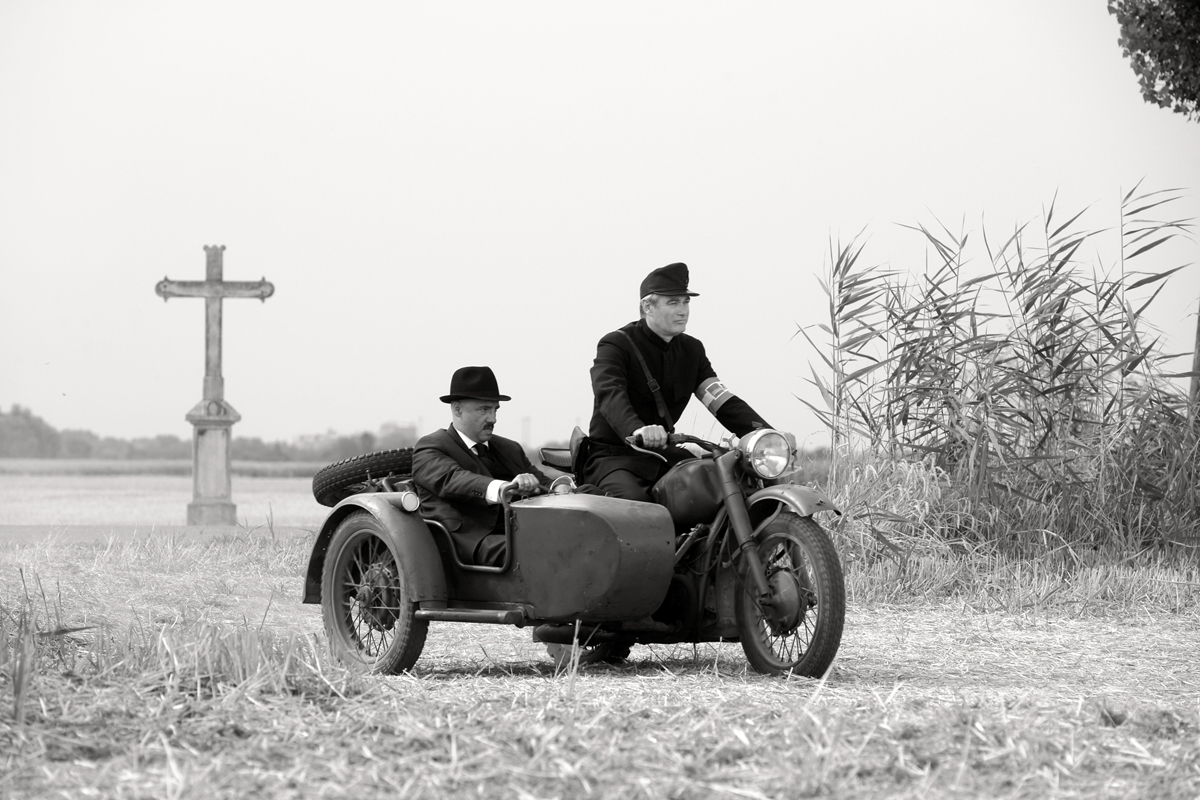
The new Hungarian film 1945 has everything going for it that a great monster movie does. It begins with simple villagers going about their lives, preparing for a joyous wedding celebration on a warm summer evening. The train stationmaster recognizes a potential existential threat from the outside that ever-so-slowly inches toward town. When he warns the town clerk, who is the father of the groom, and word spreads to other residents, losing-one’s-shit levels rise in direct correlation with the dwindling distance between them and the approaching nightmare.
Ominous sights, sounds, self-destruction among the freaked-out before doom even arrives—all the tropes of classic Universal horror movies are in director Ferenc Török’s 1945. Hell, once the “monsters” reach their destination, they are confronted by villagers toting pitchforks, à la the greeting for Dr. Frankenstein’s creation.
However, this picture, which is presented in Hungarian with English subtitles, is categorized not as horror but as drama. They are not two ugly creatures who step off a train outside the unspecified remote village on Aug. 12, 1945, but rather an older gentleman with a gray beard (Iván Angelusz, the film’s now-deceased producer) and his son (Marcell Nagy), both of them somber and dressed in black. They have with them two crates that are loaded onto a cart pulled by a horse that is guided by an older man (Miklés B. Székely).
I believe the reason M. Night Shyamalan’s The Sixth Sense was so effective to this particular watcher was because I knew nothing at all about it when I used its opening-weekend showing as an excuse to get out of the hot Las Vegas sun and into an air-conditioned theater. You, dear reader, should be afforded the same lack of knowledge going into 1945, so that it will pack the same emotional wallop.
To that end, the only other thing I will disclose about the characters played by Angelusz and Nagy is that their last name is Sámuel. World War II history buffs should also keep in mind the date they walked into the village.
Nothing against the pair’s acting, but they almost serve as props. Both barely speak. Yet their mere presence drives a story that, over 91 minutes, slowly simmers to a boil.

When it comes to acting, the star would be Péter Rudolf, who plays the town clerk István Szentes. Despite Hungary’s occupation by the Soviets—who are represented in 1945 by three low-level soldiers joyriding in a jeep, always on the lookout for something to plunder—Szentes is the domineering force over his village, drug store and family. Rudolf plays him with touches of levity and boorishness that are never over-the-top and always believable.
Being unfamiliar with Rudolf and the other cast members will actually help American audiences buy into the film. There is a believability to all the performances that leaves viewers feeling as if they are witnessing a true slice of Hungarian village life 73 summers ago.
Other actors who similarly shine, in non-showy, naturalistic ways, are Béla Gados as the slimy village priest; Jézsef Szarvas as the remorseful drunkard Bandi; Bence Tasnádi as István’s conflicted son Árpád; Déra Sztarenki as his social-climber bride-to-be, Kisrézsi; and Eszter Nagy-Kálézy, who is also married to Rudolf in real life, as Árpád’s drug-addicted mother, Anna.
The production team deserves the most credit for getting so much out of such a simple tale, which is based on the short story Homecoming by Gábor T. Szánté, who shares the screenplay credit with Török.
Putting you in that time and place are Elemér Ragályi’s luscious black-and-white cinematography and Béla Barsi’s crisp editing. I still have stuck in my head the shot of a lantern swinging under the cart on the dusty road to the village. Meanwhile, Dorka Kiss and Sosa Juristovszky nail it when it comes to the period production design and costuming, respectively.

The score from Tibor Szemzö (The Tree of Life) harkens back to that era and locale, but when it comes to filling your ears, special recognition must be given to sound designer Tamás Zányi and the foley artist or artists who supplied the clop-clop-clop sound to represent the slow gait of the horse pulling the cart to the village, accompanied by the slowly marching Sámuels. Török and his team slyly drop the clop-clop-clop into scenes in which villagers could not possibly even hear it yet, just to amplify the tension.
There are films, and I am thinking of two by Steven Spielberg and Quentin Tarantino in particular, that have been universally lauded for dealing with the same dark period for humanity. Yet, by stripping things down and shifting the focus to three months after the war ended in Europe, it is the Török team that has truly created a masterpiece.
1945 was directed by Ferenc Török; written by Gábor T. Szánté and Török; and stars Péter Rudolf, Bence Tasnádi and Déra Sztarenki. Opens Fri. at Edwards Westpark 8, 3735 Alton Pkwy., Irvine, (844) 462-7342. Call for show times; also screens Sat.-Sun. at Art Theatre, 2025 E. Fourth St., Long Beach, (562) 438-5435. Call for show times.

OC Weekly Editor-in-Chief Matt Coker has been engaging, enraging and entertaining readers of newspapers, magazines and websites for decades. He spent the first 13 years of his career in journalism at daily newspapers before “graduating” to OC Weekly in 1995 as the alternative newsweekly’s first calendar editor.

